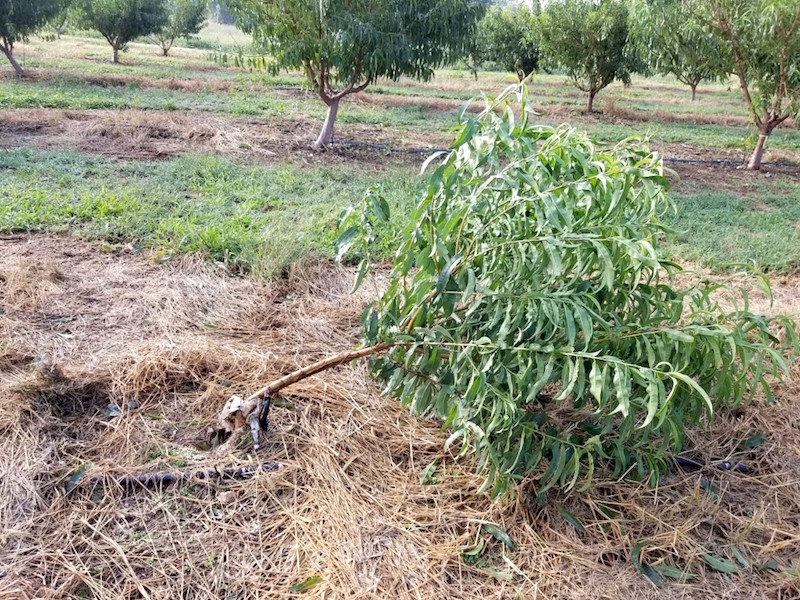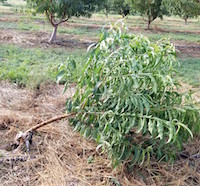Farmers aren’t the only ones busy working in their fields to repair damage from Tropical Storm Irma. As the University of Georgia’s peach specialist based on the UGA Griffin campus, my team and I have been busy trying to save young trees in our 3-year-old research orchard.
Irma passed through Georgia with strong, sustained winds. This meant trouble for our peach trees, especially for the younger trees that could have been fully uprooted.
Some of these younger trees on the university’s Dempsey Farm in Griffin were left leaning or touching the ground. Younger trees can be salvaged, but this needs to be done in the first days after the storm.
To help these trees recover, follow this advice.
Small trees tend to lean to one side. Check the opposite side of the tree to see if roots are exposed. If they are, make sure to keep them from drying.
To keep your trees upright, you will need anchors, stakes or another type of support to secure the wires or ropes in the ground. You can save money by creating your own anchors or you can buy anchor kits in a home improvement store. Cut old irrigation pipes (flexible PVC) into 6-inch pieces. You need at least two or three pieces to use around the wire or rope so it doesn’t cut into the tree.
Now that you have your supplies, it is time to place the tree upright. Do not use too much force or pull the tree in a twisting way. Keep the direction natural and in the same way the tree was originally growing. Pull steadily until the tree is in an upright position or you don’t feel too much resistance while pulling.
Once the tree is in position, use the wires or ropes to hold the tree from the main trunk or scaffolds. Make sure that the pipes cover the wires and ropes to keep them from cutting into the wood.
Set anchors for each strand. The direction of the anchors has to be set to avoid the wind moving the tree from any direction. Once you have set the anchors and the ropes are securely attached to the tree, cover the roots or any opening in the ground with soil or hay to avoid root drying.
The final step is to prune the tree to reduce the canopy. This pruning can be done to the level you would use to set the tree in the winter for the upcoming year. Leave enough foliage in place to avoid sunscalding.
Older trees that are uprooted or leaning are more difficult to save. The procedure is the same as it is for younger trees with a few additional considerations.
Avoid trying to pull the older tree to a very upright position. Do not pull the tree with a lot of strength, as it is likely that the only roots still intact are the roots in the direction that the tree is leaning. If you put too much force on the tree in an upright position, those roots are more likely to suffer damage and the tree will die.
You will probably need the help of a tractor. Make sure the tractor driver pulls the tree carefully. Consider using a small tractor to avoid excessive force.
Prepare to be content to have a tree that is not completely upright in the end. You will probably need to use many anchors and ropes. Consider using a thicker wire or rope.
Prune older trees in the manner I previously mentioned. It may also be beneficial to remove a scaffold in the direction in which the tree was leaning to avoid additional stress on the roots that are still alive. The weight of the tree will then be in the direction opposing the way it was leaning.
To receive the latest news from UGA on the peach crop in Georgia, sign up for the UGA Peach Blog at blog.extension.uga.edu/peaches/.








